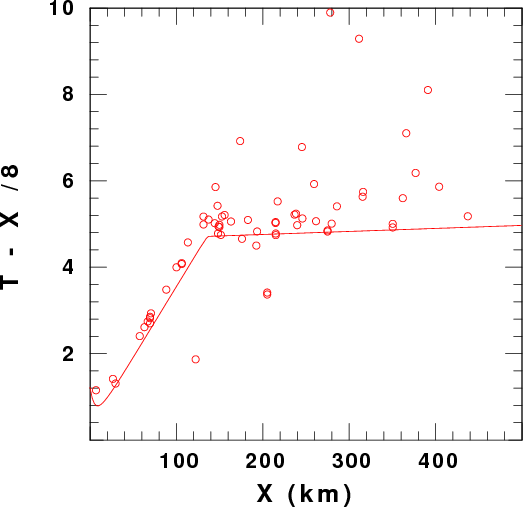
Reduced travel time plot of first arrivals
2007/01/20 11:56:53 37.68N 128.59E 8 4.55 Korea - SLU (below)
2007 01 20 11 56 54 330 37.643 128.472 10.0 4.4 USGS
2007 01 20 11 56 51 000 37.75 128.69 10.0 4.8 KNEIC
SLU Elocate solution using P and S at distances less than 100 km
2007 01 20 11 56 53 874 37.687 128.584 7.37 4.4 KOREA RBH - acc stations
Error Ellipse X= 0.3419 km Y= 0.4248 km Theta = 99.7164 deg
RMS Error : 0.150 sec
Travel_Time_Table: KOREA
Latitude : 37.6869 +- 0.0038 N 0.4227 km
Longitude : 128.5841 +- 0.0039 E 0.3446 km
Depth : 7.37 +- 0.71 km
Epoch Time : 1169294213.874 +- 0.05 sec
Event Time : 20070120115653.874 +- 0.05 sec
HYPO71 Quality : CB
Gap : 81 deg
81 phases used
STA COMP DIS(K) AZM AIN ARR TIME RES(SEC) WT QFM PHASE WGT
DGY Z 7.95 87. 131. 20070120115655.734 0.08 0 iD P 0.86
DGY Z 7.95 87. 131. 20070120115657.274 0.21 0 iX S 0.69
KAN Z 27.57 77. 102. 20070120115658.444 -0.08 0 iD P 0.86
KAN Z 27.57 77. 101. 20070120115701.932 -0.27 2 eX S 0.31
JES Z 29.42 166. 101. 20070120115658.715 -0.09 0 iC P 0.84
JES Z 29.42 166. 100. 20070120115703.003 0.29 2 eX S 0.30
TOH Z 51.72 113. 95. 20070120115702.306 -0.01 0 iD P 0.95
TOH Z 51.72 113. 94. 20070120115708.466 -0.53 2 eX S 0.21
WJU Z 56.50 236. 94. 20070120115703.313 0.24 0 iD P 0.57
WJU Z 56.50 236. 94. 20070120115710.022 -0.32 0 iX S 0.50
HOC Z 61.97 270. 93. 20070120115704.200 0.27 0 iD P 0.50
HOC Z 61.97 270. 93. 20070120115711.675 -0.22 0 iX S 0.54
SKC Z 67.23 355. 93. 20070120115704.800 0.04 0 iC P 0.69
SKC Z 67.23 355. 93. 20070120115712.659 -0.72 0 iX S 0.25
CHC Z 68.48 279. 93. 20070120115705.213 0.25 0 iD P 0.47
CHC Z 68.48 279. 93. 20070120115713.290 -0.44 2 eX S 0.18
JEC Z 68.68 210. 93. 20070120115705.099 0.11 2 eC P 0.30
JEC Z 68.68 210. 93. 20070120115713.303 -0.49 0 iX S 0.33
TBA Z 70.67 152. 93. 20070120115705.461 0.15 0 iC P 0.53
CHY Z 88.31 160. 92. 20070120115708.229 0.13 0 iC P 0.44
CHY Z 88.31 160. 92. 20070120115718.534 -0.82 2 eX S 0.09
YOJ Z 91.20 184. 92. 20070120115708.608 0.05 0 iC P 0.49
YAP Z 98.95 257. 92. 20070120115710.223 0.44 0 iD P 0.24
CHJ Z 105.32 211. 92. 20070120115711.051 0.26 0 iD P 0.30
CHJ Z 105.32 211. 92. 20070120115723.340 -0.83 0 iX S 0.14
ICN Z 112.09 247. 92. 20070120115712.443 0.58 0 iD P 0.18
CWO Z 121.77 310. 91. 20070120115710.861 -2.53 0 iC P 0.03
CWO Z 121.77 310. 91. 20070120115722.943 -5.88 0 iX S 0.01
AND Z 124.24 175. 91. 20070120115714.171 0.39 0 iC P 0.21
AND Z 124.24 175. 91. 20070120115728.830 -0.70 0 iX S 0.14
ULJ Z 131.60 146. 79. 20070120115715.303 0.38 0 iC P 0.20
ULJ Z 131.60 146. 80. 20070120115730.769 -0.83 2 eX S 0.06
DDC Z 136.17 280. 79. 20070120115715.969 0.33 0 iD P 0.21
DDC Z 136.17 280. 80. 20070120115732.288 -0.59 2 eX S 0.07
SOD Z 143.17 265. 52. 20070120115716.777 0.22 2 e- P 0.12
BON Z 144.50 209. 52. 20070120115717.722 1.00 2 e- P 0.04
SAJ Z 147.09 195. 52. 20070120115717.582 0.53 0 iC P 0.14
YOD Z 148.36 150. 52. 20070120115717.013 -0.20 0 iC P 0.24
YOD Z 148.36 150. 53. 20070120115735.222 -0.52 2 eX S 0.07
SEO Z 148.51 262. 52. 20070120115717.357 0.13 0 iD P 0.26
EUS Z 148.65 176. 52. 20070120115717.254 0.01 0 iC P 0.33
EUS Z 148.65 176. 53. 20070120115735.406 -0.40 2 eX S 0.09
SWO Z 150.26 252. 52. 20070120115717.394 -0.06 0 iD P 0.30
CEA Z 151.73 231. 52. 20070120115717.987 0.35 0 iD P 0.18
CEJ Z 154.84 221. 52. 20070120115718.393 0.36 2 eX P 0.09
MUS Z 162.02 278. 52. 20070120115719.163 0.23 2 e- P 0.10
INC Z 174.65 263. 52. 20070120115720.357 -0.17 0 iD P 0.21
INC Z 174.65 263. 93. 20070120115742.848 -0.97 2 eX Lg 0.04
PHA Z 180.17 157. 52. 20070120115721.183 -0.04 2 e+ P 0.13
PHA Z 180.17 157. 93. 20070120115744.931 -0.46 2 eX Lg 0.06
TEJ Z 181.91 217. 52. 20070120115721.651 0.20 2 e- P 0.09
TEJ Z 181.91 217. 93. 20070120115745.109 -0.78 2 eX Lg 0.04
YJD Z 191.25 263. 52. 20070120115722.279 -0.35 2 eX P 0.07
YOC Z 193.45 170. 52. 20070120115722.722 -0.18 0 iC P 0.18
YOC Z 193.45 170. 93. 20070120115748.287 -0.90 2 eX Lg 0.04
ULL Z 205.69 96. 52. 20070120115722.760 -1.69 0 iD P 0.03
SES Z 213.53 243. 52. 20070120115725.582 0.14 0 iD P 0.18
DAG Z 215.01 172. 52. 20070120115725.370 -0.26 0 iC P 0.15
BUY Z 216.16 224. 52. 20070120115726.377 0.61 2 eX P 0.04
POR Z 235.64 231. 52. 20070120115728.520 0.29 2 eX P 0.06
ANM Z 237.24 238. 52. 20070120115728.756 0.32 0 iC P 0.12
HAC Z 239.54 189. 52. 20070120115728.660 -0.06 0 iC P 0.18
CHO Z 243.71 212. 52. 20070120115731.413 2.16 2 eX P 0.01
JAS Z 244.75 203. 52. 20070120115731.156 1.77 2 eX P 0.01
ULS Z 245.94 164. 52. 20070120115729.565 0.03 2 eX P 0.10
IMS Z 258.71 207. 52. 20070120115732.053 0.91 2 eX P 0.03
SAC Z 261.27 194. 52. 20070120115731.477 0.01 2 e+ P 0.09
BUS Z 275.04 170. 52. 20070120115732.905 -0.30 2 e+ P 0.05
NAW Z 277.46 204. 52. 20070120115738.356 4.85 2 eX P 0.00
MAS Z 279.63 180. 52. 20070120115733.678 -0.11 0 iC P 0.15
JEU Z 285.05 212. 52. 20070120115734.839 0.37 2 eX P 0.05
KUJ Z 311.43 180. 52. 20070120115741.927 4.13 2 eX P 0.00
TOY Z 316.04 182. 52. 20070120115738.964 0.58 2 eX P 0.03
BRD Z 348.92 276. 52. 20070120115742.429 -0.10 0 iD P 0.12
KOH Z 361.72 199. 52. 20070120115744.565 0.41 2 eX P 0.03
JAH Z 365.56 205. 52. 20070120115746.564 1.93 2 eX P 0.01
MOP Z 376.23 212. 52. 20070120115747.003 1.02 2 eX P 0.02
HAN Z 390.55 208. 52. 20070120115750.697 2.91 2 eX P 0.00
WAN Z 403.67 205. 52. 20070120115750.087 0.64 2 eX P 0.02
HUK Z 436.41 221. 52. 20070120115753.551 -0.03 2 e- P 0.05
JJU Z 507.61 202. 52. 20070120115805.511 2.94 2 eX P 0.00
KOREA VELOCITY MODEL IN MODIFIED HYPO71 FORMAT
KOREA
15 3
'P' 'S' 'Lg'
0.00 5.38 3.00 3.50
1.00 5.81 3.24 3.50
2.00 6.17 3.44 3.50
3.00 6.29 3.51 3.50
6.00 6.32 3.53 3.50
11.00 6.42 3.58 3.50
16.00 6.56 3.66 3.50
20.00 6.64 3.70 3.50
25.00 6.65 3.71 3.50
27.50 7.10 3.96 3.50
30.00 7.92 4.41 3.50
32.50 7.89 4.40 3.50
35.00 7.87 4.39 3.50
40.00 7.57 4.22 3.50
45.00 7.76 4.33 3.50
Using the vbelocity model in model96 format (t6.invSNU.CUVEL.mod), the program timmod96 was used to overlay the first arrival picks (converted to travel times) onto the predicted P-wave first arrival time. The script used was DOPTIMEPLOT. The offset indicates the degree to which the S arrivals bias the origin time. It is obvious that the Pg arrivals are easily picked. I note that the Pn arrivals are very low amplitude, single pulses on the seismograms. Obviously many of the Pn arrivals are affected by noise.
 Reduced travel time plot of first arrivals |
SLU Moment Tensor Solution
2007/01/20 11:56:53 37.68N 128.59E 8 4.55 Korea
Best Fitting Double Couple
Mo = 8.41e+22 dyne-cm
Mw = 4.55
Z = 9 km
Plane Strike Dip Rake
NP1 205 85 -175
NP2 115 85 -5
Principal Axes:
Axis Value Plunge Azimuth
T 8.41e+22 0 340
N 0.00e+00 83 250
P -8.41e+22 7 70
Moment Tensor: (dyne-cm)
Component Value
Mxx 6.50e+22
Mxy -5.32e+22
Mxz -3.46e+21
Myy -6.37e+22
Myz -9.67e+21
Mzz -1.27e+21
T ############
### #############---
#####################-------
#####################---------
######################------------
######################--------------
-#####################--------------
-----#################--------------- P
--------#############----------------
------------#########---------------------
----------------####----------------------
-------------------#----------------------
------------------######------------------
----------------###########-------------
----------------################--------
--------------######################--
------------########################
----------########################
--------######################
------######################
--####################
##############
Harvard Convention
Moment Tensor:
R T F
-1.27e+21 -3.46e+21 9.67e+21
-3.46e+21 6.50e+22 5.32e+22
9.67e+21 5.32e+22 -6.37e+22
Detailed analysis: http://mnw.eas.slu.edu/eqc/eqc_mt/MECH.KR/20070120115654/
|
The focal mechanism was determined using accelerometer waveforms integrated to ground velocity. The location of the event and the station distribution are given in Figure 1.
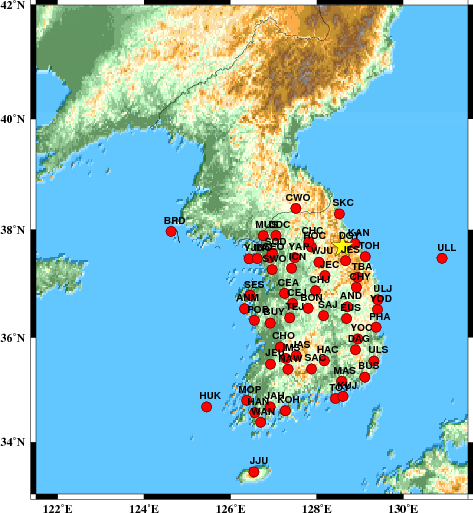
|
|
|
STK = 115
DIP = 85
RAKE = -5
MW = 4.55
HS = 9
The waveform inversion is preferred. This solution agrees with the surface-wave solution. This solution is well determined. Because of the size of this earthquake, waveform inversion was also performed using the accelereometer data converted to ground velocity. Care was taken to use the accelerometer traces only in the 0.05 - 0.2 Hz band, while the broadband sensor data were analyzed as usual in the 0.02 - 0.10 Hz band.
The program wvfgrd96 was used with good traces observed at short distance to determine the focal mechanism, depth and seismic moment. This technique requires a high quality signal and well determined velocity model for the Green functions. To the extent that these are the quality data, this type of mechanism should be preferred over the radiation pattern technique which requires the separate step of defining the pressure and tension quadrants and the correct strike.
The observed and predicted traces are filtered using the following gsac commands:
hp c 0.05 3 lp c 0.20 3The results of this grid search from 0.5 to 19 km depth are as follow:
DEPTH STK DIP RAKE MW FIT
WVFGRD96 0.5 105 70 -25 4.22 0.3956
WVFGRD96 1.0 110 70 -20 4.24 0.4180
WVFGRD96 2.0 110 75 -20 4.30 0.4565
WVFGRD96 3.0 110 75 -15 4.35 0.5034
WVFGRD96 4.0 110 80 -20 4.40 0.5563
WVFGRD96 5.0 115 80 -15 4.45 0.6021
WVFGRD96 6.0 115 80 -10 4.48 0.6388
WVFGRD96 7.0 115 80 -10 4.51 0.6681
WVFGRD96 8.0 115 85 -10 4.54 0.6844
WVFGRD96 9.0 115 85 -5 4.55 0.6890
WVFGRD96 10.0 115 85 -5 4.57 0.6873
WVFGRD96 11.0 295 90 5 4.59 0.6862
WVFGRD96 12.0 115 90 0 4.60 0.6805
WVFGRD96 13.0 295 90 0 4.61 0.6751
WVFGRD96 14.0 295 85 0 4.62 0.6628
WVFGRD96 15.0 295 85 -5 4.62 0.6495
WVFGRD96 16.0 295 85 -5 4.63 0.6332
WVFGRD96 17.0 295 85 -5 4.64 0.6169
WVFGRD96 18.0 295 85 -5 4.65 0.6036
WVFGRD96 19.0 290 75 -10 4.64 0.5897
The best solution is
WVFGRD96 9.0 115 85 -5 4.55 0.6890
The mechanism correspond to the best fit is

|
|
|
The best fit as a function of depth is given in the following figure:

|
|
|
The comparison of the observed and predicted waveforms is given in the next figure. The red traces are the observed and the blue are the predicted. Each observed-predicted componnet is plotted to the same scale and peak amplitudes are indicated by the numbers to the left of each trace. The number in black at the rightr of each predicted traces it the time shift required for maximum correlation between the observed and predicted traces. This time shift is required because the synthetics are not computed at exactly the same distance as the observed and because the velocity model used in the predictions may not be perfect. A positive time shift indicates that the prediction is too fast and should be delayed to match the observed trace (shift to the right in this figure). A negative value indicates that the prediction is too slow. The bandpass filter used in the processing and for the display was
hp c 0.05 3 lp c 0.20 3

|
|
|

|
| Focal mechanism sensitivity at the preferred depth. The red color indicates a very good fit to thewavefroms. Each solution is plotted as a vector at a given value of strike and dip with the angle of the vector representing the rake angle, measured, with respect to the upward vertical (N) in the figure. |
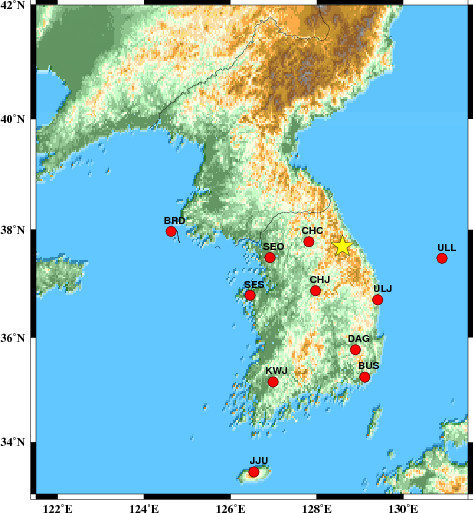
|
|
|
The program wvfgrd96 was used with good traces observed at short distance to determine the focal mechanism, depth and seismic moment. This technique requires a high quality signal and well determined velocity model for the Green functions. To the extent that these are the quality data, this type of mechanism should be preferred over the radiation pattern technique which requires the separate step of defining the pressure and tension quadrants and the correct strike.
The observed and predicted traces are filtered using the following gsac commands:
hp c 0.02 3 lp c 0.10 3The results of this grid search from 0.5 to 19 km depth are as follow:
DEPTH STK DIP RAKE MW FIT
WVFGRD96 0.5 290 80 -15 4.37 0.5586
WVFGRD96 1.0 290 85 -10 4.38 0.5890
WVFGRD96 2.0 295 90 -5 4.43 0.6387
WVFGRD96 3.0 110 75 -15 4.46 0.6684
WVFGRD96 4.0 115 75 -5 4.48 0.6925
WVFGRD96 5.0 115 80 -10 4.50 0.7186
WVFGRD96 6.0 115 80 -5 4.51 0.7454
WVFGRD96 7.0 115 80 -5 4.52 0.7674
WVFGRD96 8.0 115 85 -5 4.53 0.7835
WVFGRD96 9.0 115 85 -5 4.54 0.7946
WVFGRD96 10.0 115 85 -5 4.55 0.8005
WVFGRD96 11.0 115 85 -5 4.56 0.8027
WVFGRD96 12.0 115 85 -5 4.57 0.8017
WVFGRD96 13.0 115 90 -5 4.58 0.7975
WVFGRD96 14.0 295 90 5 4.58 0.7912
WVFGRD96 15.0 295 90 5 4.59 0.7851
WVFGRD96 16.0 115 90 -5 4.60 0.7771
WVFGRD96 17.0 115 90 -5 4.60 0.7685
WVFGRD96 18.0 115 85 5 4.61 0.7647
WVFGRD96 19.0 115 85 5 4.62 0.7529
The best solution is
WVFGRD96 11.0 115 85 -5 4.56 0.8027
The mechanism correspond to the best fit is
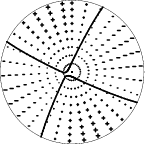
|
|
|
The best fit as a function of depth is given in the following figure:
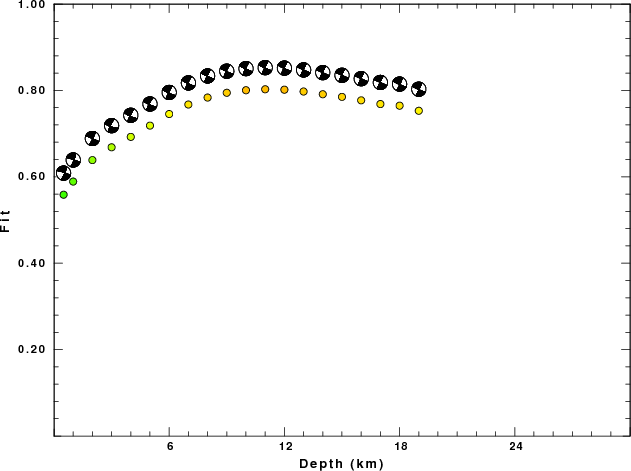
|
|
|
The comparison of the observed and predicted waveforms is given in the next figure. The red traces are the observed and the blue are the predicted. Each observed-predicted componnet is plotted to the same scale and peak amplitudes are indicated by the numbers to the left of each trace. The number in black at the rightr of each predicted traces it the time shift required for maximum correlation between the observed and predicted traces. This time shift is required because the synthetics are not computed at exactly the same distance as the observed and because the velocity model used in the predictions may not be perfect. A positive time shift indicates that the prediction is too fast and should be delayed to match the observed trace (shift to the right in this figure). A negative value indicates that the prediction is too slow. The bandpass filter used in the processing and for the display was
hp c 0.02 3 lp c 0.10 3
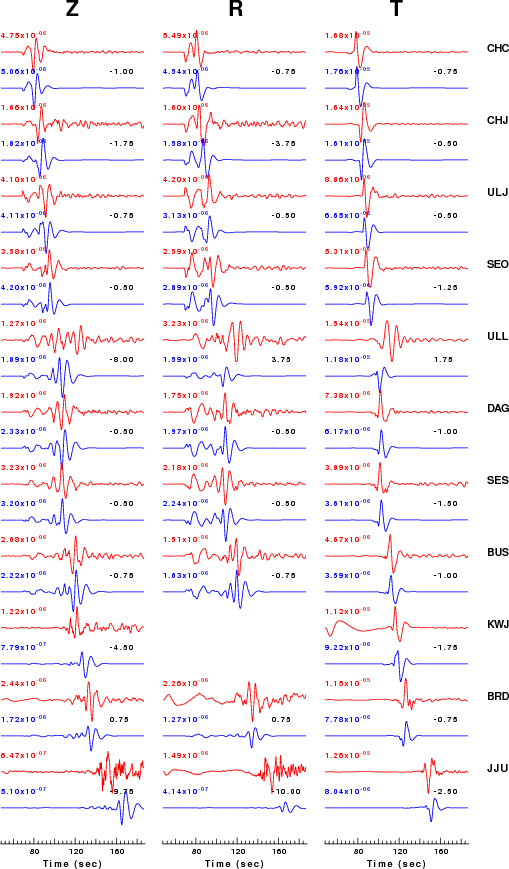
|
|
|
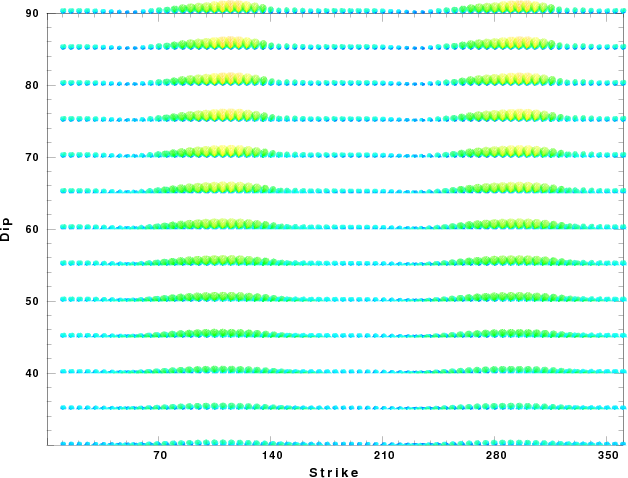
|
| Focal mechanism sensitivity at the preferred depth. The red color indicates a very good fit to thewavefroms. Each solution is plotted as a vector at a given value of strike and dip with the angle of the vector representing the rake angle, measured, with respect to the upward vertical (N) in the figure. |
Broadband data for INCN and MDJ were obtained from the IRIS DMC. These waveform data were not inverted. Instead synthetics were generated using the preferred moment tensor solution given above. The ground velocity wasfiltered using the command
hp c 0.01 3 lp c 0.10 3
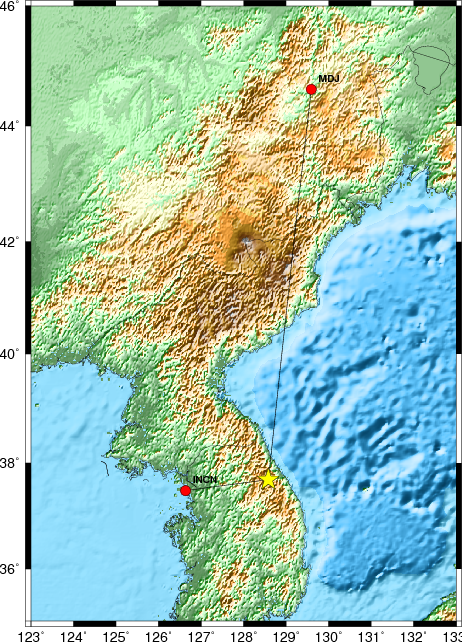
|
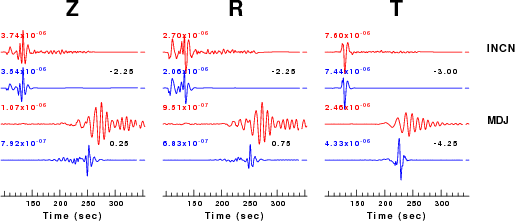
|
NODAL PLANES
STK= 25.00
DIP= 90.00
RAKE= 180.00
OR
STK= 115.00
DIP= 90.00
RAKE= 0.00
DEPTH = 10.0 km
Mw = 4.61
Best Fit 0.9289 - P-T axis plot gives solutions with FIT greater than FIT90
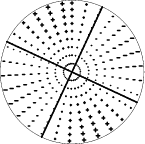 |
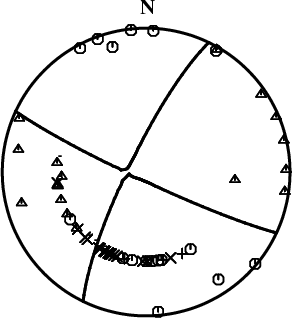
|
The P-wave first motion plot using the Elocate location and take-off angles and the preferred focal mechanism is given here |
The P-wave first motion data for focal mechanism studies are as follow:
Sta Az(deg) Dist(km) First motion DGY 91 7 iP_D KAN 77 27 iP_D JES 168 30 iP_C TOH 114 51 iP_D WJU 237 58 iP_D HOC 269 63 iP_D SKC 355 67 iP_C CHC 278 69 iP_D JEC 211 70 eP_C TBA 153 71 iP_C CHY 161 88 iP_C YOJ 184 92 iP_C YAP 257 100 iP_D CHJ 211 106 iP_D ICN 247 113 iP_D CWO 310 122 iP_C AND 175 124 iP_C ULJ 146 131 iP_C DDC 280 137 iP_D SOD 265 144 eP_- BON 209 145 eP_- SAJ 195 148 iP_C YOD 151 148 iP_C EUS 177 149 iP_C SEO 262 150 iP_D SWO 252 152 iP_D CEA 231 153 iP_D CEJ 222 156 eP_X MUS 278 163 eP_- INC 263 176 iP_D PHA 157 180 eP_+ TEJ 217 183 eP_- YJD 263 193 eP_X YOC 170 193 iP_C ULL 96 205 iP_D DAG 173 215 iP_C SES 243 215 iP_D BUY 224 217 eP_X POR 231 237 eP_X ANM 238 238 iP_C HAC 189 240 iP_C CHO 212 244 eP_X JAS 203 245 eP_X ULS 164 246 eP_X IMS 207 259 eP_X SAC 194 262 eP_+ BUS 170 275 eP_+ NAW 204 278 eP_X MAS 180 280 iP_C JEU 212 286 eP_X KUJ 180 311 eP_X TOY 183 316 eP_X BRD 276 350 iP_D KOH 200 362 eP_X JAH 205 366 eP_X MOP 213 377 eP_X HAN 208 391 eP_X WAN 206 404 eP_X HUK 221 437 eP_- JJU 202 508 eP_X
Surface wave analysis was performed using codes from Computer Programs in Seismology, specifically the multiple filter analysis program do_mft and the surface-wave radiation pattern search program srfgrd96.
Digital data were collected, instrument response removed and traces converted
to Z, R an T components. Multiple filter analysis was applied to the Z and T traces to obtain the Rayleigh- and Love-wave spectral amplitudes, respectively.
These were input to the search program which examined all depths between 1 and 25 km
and all possible mechanisms.
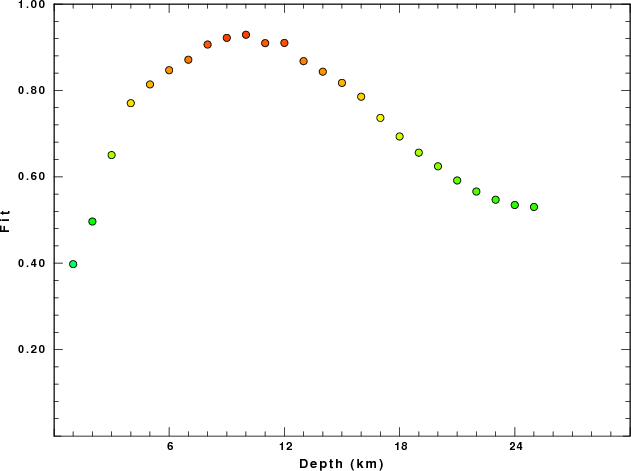
|
|
|

|
| Pressure-tension axis trends. Since the surface-wave spectra search does not distinguish between P and T axes and since there is a 180 ambiguity in strike, all possible P and T axes are plotted. First motion data and waveforms will be used to select the preferred mechanism. The purpose of this plot is to provide an idea of the possible range of solutions. The P and T-axes for all mechanisms with goodness of fit greater than 0.9 FITMAX (above) are plotted here. |
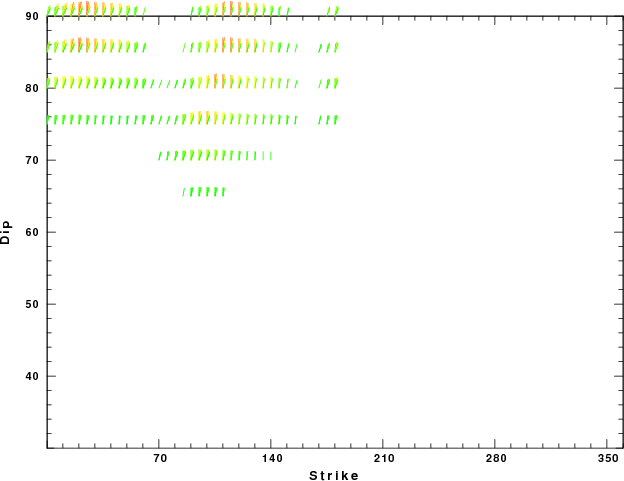
|
| Focal mechanism sensitivity at the preferred depth. The red color indicates a very good fit to the Love and Rayleigh wave radiation patterns. Each solution is plotted as a vector at a given value of strike and dip with the angle of the vector representing the rake angle, measured, with respect to the upward vertical (N) in the figure. Because of the symmetry of the spectral amplitude rediation patterns, only strikes from 0-180 degrees are sampled. |
The distribution of broadband stations with azimuth and distance is
Sta Az(deg) Dist(km) CHC 278 69 CHJ 211 106 ULJ 146 131 SEO 262 150 INCN 263 174 DAG 173 215 SES 243 215 BUS 170 275 KWJ 208 316 BRD 276 350 JJU 202 508
Since the analysis of the surface-wave radiation patterns uses only spectral amplitudes and because the surfave-wave radiation patterns have a 180 degree symmetry, each surface-wave solution consists of four possible focal mechanisms corresponding to the interchange of the P- and T-axes and a roation of the mechanism by 180 degrees. To select one mechanism, P-wave first motion can be used. This was not possible in this case because all the P-wave first motions were emergent ( a feature of the P-wave wave takeoff angle, the station location and the mechanism). The other way to select among the mechanisms is to compute forward synthetics and compare the observed and predicted waveforms.
The fits to the waveforms with the given mechanism are show below:
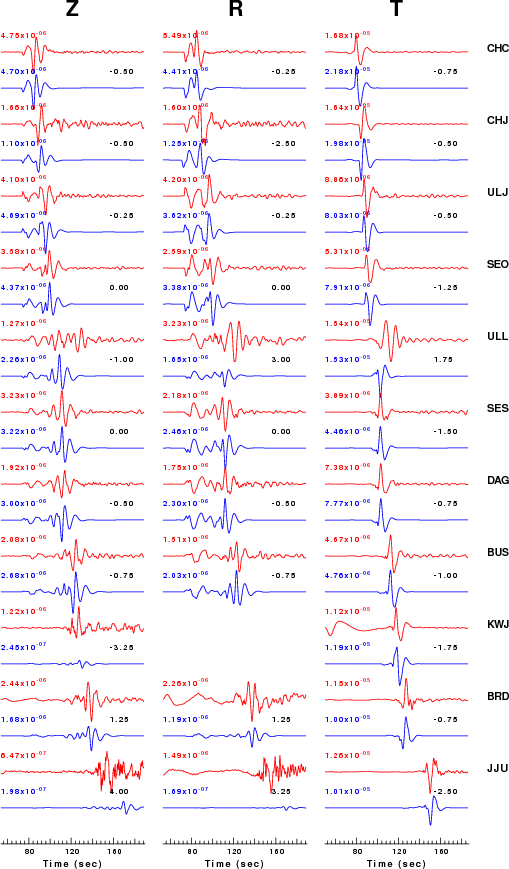
|
This figure shows the fit to the three components of motion (Z - vertical, R-radial and T - transverse). For each station and component, the observed traces is shown in red and the model predicted trace in blue. The traces represent filtered ground velocity in units of meters/sec (the peak value is printed adjacent to each trace; each pair of traces to plotted to the same scale to emphasize the difference in levels). Both synthetic and observed traces have been filtered using the SAC commands:
hp c 0.02 3 lp c 0.10 3
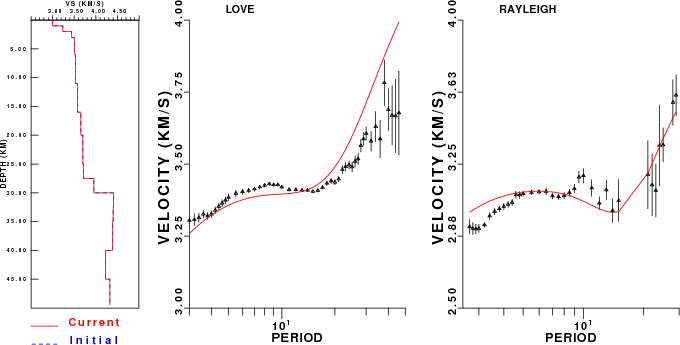
|
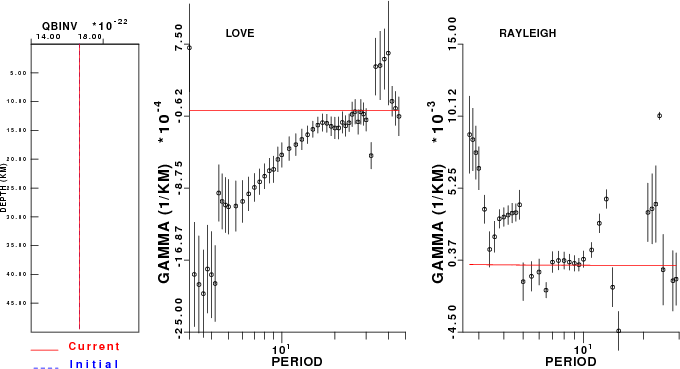
|
The figures below show the observed spectral amplitudes (units of cm-sec) at each station and the
theoretical predictions as a function of period for the mechanism given above. The modified Utah model earth model
was used to define the Green's functions. For each station, the Love and Rayleigh wave spectrail amplitudes are plotted with the same scaling so that one can get a sense fo the effects of the effects of the focal mechanism and depth on the excitation of each.
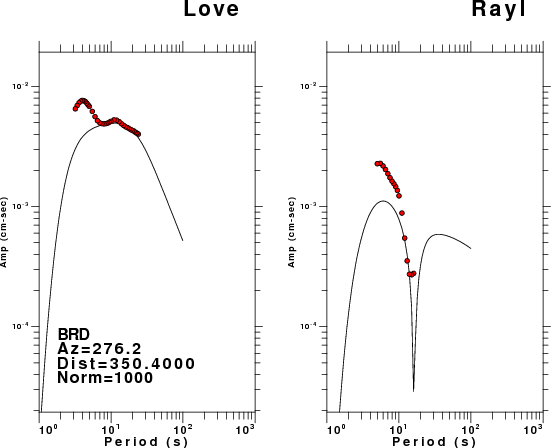 |
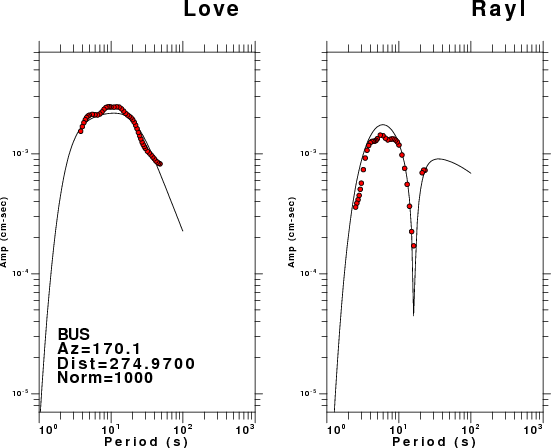 |
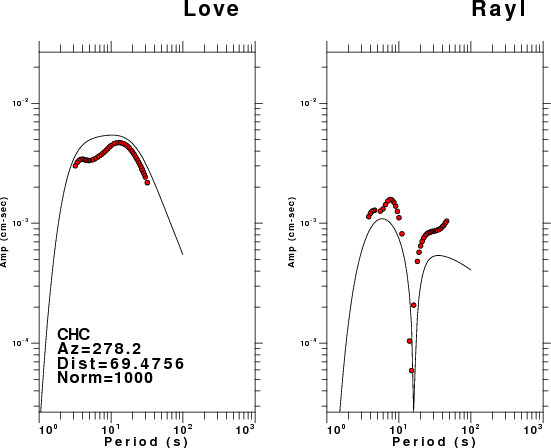 |
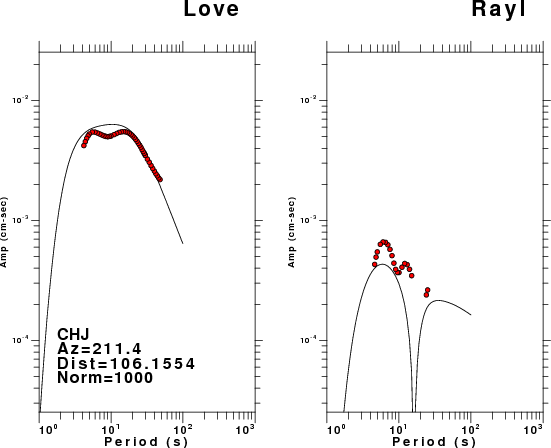 |
 |
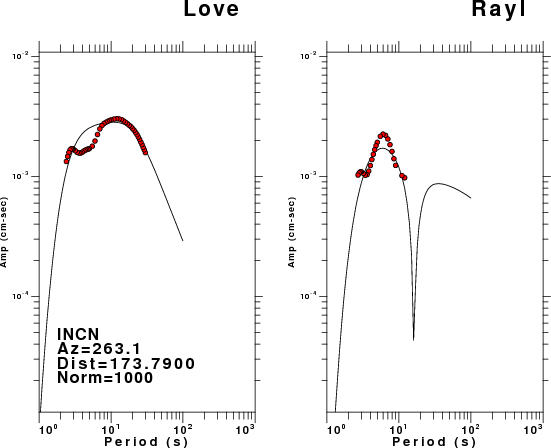 |
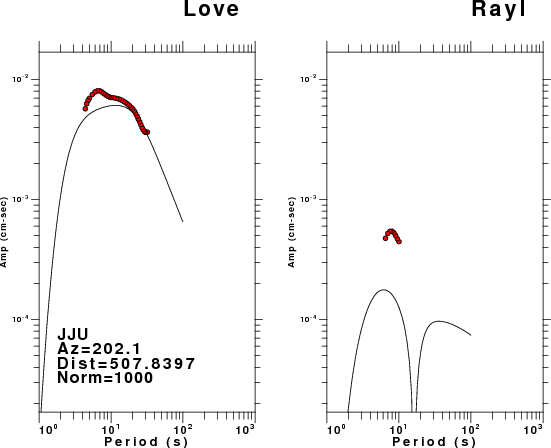 |
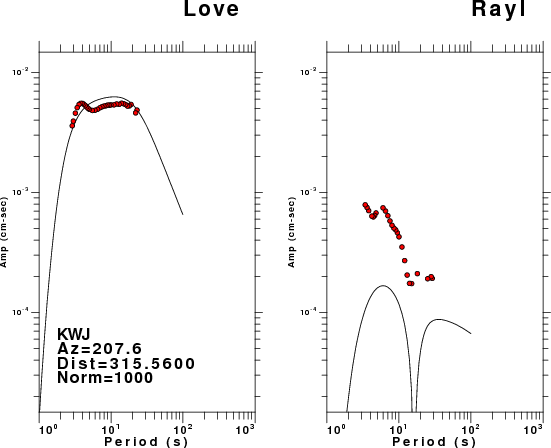 |
 |
 |
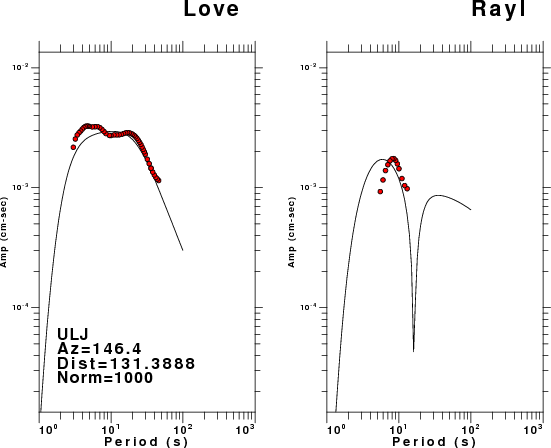 |
Here we tabulate the reasons for not using certain digital data sets
PyeongChang's Olympic Bid Not Shaken by Tremor
Saturday’s moderate earthquake will not affect a bid by PyeongChang to host the 2014 Winter Olympics, a bid committee official said on Sunday.
PyeongChang, 150 kilometers east of Seoul, was cited as the epicenter of the quake that shook the country's eastern coastal region.
The tremor left some cracks in very old houses and buildings, but caused no damage to roads and other infrastructure,’’ Bang Jae-heung, secretary-general of the 2014 PyeongChang Olympic Winter Games Bid Committee, said.
Bang said the committee will make thorough preparations for the upcoming due diligence on its ability to host the games by the International Olympic Committee (IOC). The IOC inspections are scheduled for Feb. 14-17.
We hope that the earthquake will not create a bad image of PyeongChang. It was the first earthquake to affect the area, which has never been classified as earthquake-prone,’’ Bang said.
PyeongChang is vying to host the Winter Olympics and Paralympics along with two other contenders _ Salzburg, Austria, and Russia's Black Sea town of Sochi.
PyeongChang lost its bid for the 2010 Olympics to Vancouver, Canada, by only three votes. The final IOC vote on the 2014 Winter Olympics will take place in Guatemala in July.
If PyeongChang is successful, it would be the third Asian city to host the Winter Games. Two Japanese cities, Sapporo and Nagano, hosted the games in 1972 and 1998, respectively.